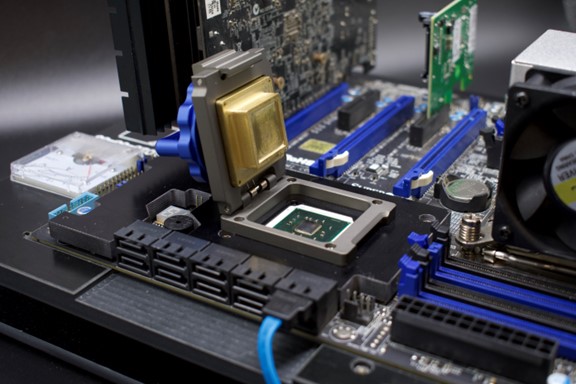Standardizing CPU Validation: From Functional Verification to Long-Term Reliability
1. Why Benchmark Scores Don’t Tell the Whole Story
2. Functional Verification — Speaking the CPU’s Native Truth
3. Performance Characterization — Every Cycle Counts
4. Power, Thermal, and Reliability — Where Computation Meets Physics
5. The Case for Independent Validation
Introduction
Inside the Science, Engineering, and Trust Behind Modern Processor Testing
By GLOBAL ETS LLC — Independent Semiconductor Validation Laboratory

In today’s compute-driven economy, every nanometer of silicon carries immense strategic weight. For chip designers, OEMs, and investors alike, the true question is no longer “How fast is your CPU?” but rather: “Can it sustain that performance, under any workload, in any environment, over its entire lifetime?”
CPU validation and characterization answer that question. It is the disciplined science that transforms theoretical design into verified, dependable performance. At GLOBAL ETS LLC, our mission is to measure—not market—processor capability. Through standardized methodology, calibrated instrumentation, and engineering transparency, we quantify performance, efficiency, and reliability in ways that turn data into trust.
1. Why Benchmark Scores Don’t Tell the Whole Story
When Intel launched its 12th-generation Core series, promotional slides touted “up to 20% performance improvement.” That figure was genuine—but specific to one benchmark configuration, with tightly controlled power and thermal limits. In practice, CPU behavior depends on a far more intricate ecosystem: instruction scheduling, cache coherence, branch prediction accuracy, compiler optimizations, and even DRAM latency.

Performance is multidimensional. A single benchmark number collapses a complex dynamic system into one scalar value.
At GLOBAL ETS LLC, we move beyond synthetic scores like SPECint or Geekbench. Our validation engineers focus on why a CPU performs as it does—and under which workloads, voltages, and temperatures those characteristics shift. It’s not about “faster.” It’s about scientific accountability.
2. Functional Verification — Speaking the CPU’s Native Truth
Before a processor can be fast, it must be correct. Functional verification ensures that a CPU executes its instruction set architecture (ISA) faithfully, without undefined behavior or timing violations.
2.1 Instruction-Set Compliance
For open architectures like RISC-V, compliance starts with the official ISA validation suite. Each sequence is executed both on silicon and in a “golden model” simulator (e.g., Spike for RISC-V or Intel’s internal x86 model). Register and memory states must match cycle by cycle. Discrepancies expose subtle design flaws—the same kind that once triggered speculative-execution vulnerabilities like Spectre and Meltdown.
2.2 Timing and Microarchitectural Integrity
Correct results alone are insufficient; they must arrive at the correct time. When Intel transitioned to its Haswell microarchitecture, deeper out-of-order logic introduced rare timing deadlocks. Cycle-accurate emulation reproduced those corner cases and led to targeted microcode fixes.
Our lab performs similar cycle-level timing tests using FPGA-based prototypes. Booting a full Linux kernel on such a prototype is considered the minimum “proof of life.” If the kernel scheduler, TLB, and cache subsystems initialize without anomalies, the CPU earns its first pass toward functional maturity.
3. Performance Characterization — Every Cycle Counts
Once correctness is proven, efficiency becomes the target. A CPU’s effective throughput depends on IPC (Instructions Per Cycle), pipeline depth, memory hierarchy, and scheduling balance.
3.1 Pipeline Efficiency and Bottleneck Mapping
Consider Intel’s Golden Cove cores in Alder Lake: theoretical IPC ≈ 2.0 under ideal conditions. Yet under branch-heavy code, misprediction beyond 5% can collapse IPC to 1.2. Through hardware performance counters (PMU data), we measure:
- Retired instructions
- Branch mispredicts
- Cache misses
- Stall cycles
We visualize these as a Bottleneck Map.
Such granular diagnostics allow design teams to resolve architectural bottlenecks before tape-out—saving months of silicon revision.
3.2 Real-World Workload Modeling
Synthetic benchmarks show theoretical potential; application-mirrored tests reveal operational truth. At GLOBAL ETS LLC we craft custom workload models for each client:
- AI accelerators → TensorFlow Lite INT8 inference throughput
- Automotive controllers → real-time interrupt latency under ISO 26262 loads
- Industrial CPUs → fixed-point DSP loops and sensor fusion latency
Tests run across voltage, temperature, and frequency sweeps to produce P–V–F curves (Power-Voltage-Frequency). These curves highlight efficiency plateaus—the same principle behind Intel’s Adaptive Boost and AMD’s Precision Boost 2 algorithms.
4. Power, Thermal, and Reliability — Where Computation Meets Physics

All computation is thermodynamics in disguise. A CPU’s sustainability depends on how it manages heat, power, and material fatigue.
4.1 Power Distribution and Hotspot Visualization
We deploy calibrated current probes and infrared thermography to map energy flow across the die. Under full stress, an Intel Core i9-13900K can reach localized hotspots above 95°C. AMD’s Ryzen 9 7950X, with chiplet topology, disperses heat more uniformly—lower peaks but broader gradients.
Such thermal signatures inform cooling design and packaging optimization. We then perform thermal cycling (−40°C ↔ +125°C) to evaluate solder integrity and TIM reliability—a critical metric for aerospace and automotive deployments.
4.2 Burn-In and Aging Analysis
Performance over minutes is marketing; performance over years is engineering. GLOBAL ETS LLC conducts High-Temperature Operating Life (HTOL) and Power Cycling tests: hundreds of continuous hours under elevated voltage and temperature, monitoring:
- Threshold-voltage drift (BTI/HCI effects)
- Supply-rail transient tolerance
- Clock-jitter evolution and timing margin loss
From these data we derive reliability curves, estimating FIT (Failures-in-Time). This long-term perspective ensures each processor not only meets launch specs but sustains them across its operational lifespan.
5. The Case for Independent Validation
Even the best internal test team benefits from external verification. In CPU validation, objectivity is a measurable quantity.
5.1 Neutrality and Credibility
As an independent ISO/IEC 17025-accredited facility, GLOBAL ETS LLC operates free from design bias. Our reports comply with JEDEC, IEEE, and ISO 26262 frameworks—making them admissible for OEM qualification, investor due diligence, and regulatory audits. This impartial validation adds tangible business value, echoing Intel’s early collaborations with UL (Underwriters Laboratories) for server-grade certification.
5.2 Repeatability and Traceability
Every dataset carries a digital lineage:
- Instrument model & calibration ID
- Environmental logs (temperature, humidity, supply ripple)
- Firmware and test-script hash
- Timestamp and operator signature
This provenance enables complete reproducibility—the scientific foundation of reliable testing.
5.3 System-Level Insight
A processor’s performance depends on its ecosystem: memory controllers, I/O interconnects, voltage regulators, and cooling design. We extend validation to the system level, measuring DDR latency, PCIe integrity, and transient power response.
Apple’s M-series chips illustrate this integration: unified memory and neural accelerators deliver exceptional efficiency beyond CPU cores alone. Our mission is to quantify such systemic synergy—transforming qualitative design claims into numerical evidence.
6. From Verification to Trust
CPU validation is not a checkbox—it is a continuous feedback loop between design, physics, and measurement. It unites disciplines from microarchitecture to materials science, from data analytics to thermodynamics.
Every validation cycle, every hour of burn-in, and every waveform captured on an oscilloscope contributes to one overarching goal: trust.
Trust comes from verification. Verification comes from science. And science demands independence.
At GLOBAL ETS LLC, we see every processor not as a product, but as a promise—one that must be proven, measured, and sustained.
About GLOBAL ETS LLC

GLOBAL ETS LLC is an independent, ISO/IEC 17025-certified semiconductor testing and validation laboratory. We specialize in CPU, AI-accelerator, and SoC performance and reliability assessment—from instruction-set compliance and microarchitectural analysis to thermal mapping and lifetime aging studies.
Our multidisciplinary team combines hardware instrumentation, software automation, and statistical modeling to deliver transparent, reproducible data trusted by OEMs, design houses, and research institutions worldwide.


 ISO 17025, AS6171, AS6081
ISO 17025, AS6171, AS6081 DLA Lab Suitability
DLA Lab Suitability ITAR
ITAR